|
|
|
|
Nonkilling Arts Research Committee Letter: Vol. 5, N. 4 (July-August 2021)
|
|
|
|
|
Dear NKARC members and friends,
Two important days — the Global Nonkilling Day and the Days of Atomic bombings on Hiroshima and Nagasaki, these are interlinked through Right to Life. I wonder why that Right is never mentioned when discussions of Human Rights take place. The contributions we received for this Letter are about Nonkilling responsibility “Not to kill and Not to be killed” as an individual, as a nation, and as a member of global humanity.
|
|
1. Nonkilling Poetry
The four poems below are affirmations of Self through Love, Peace, Kindness, Forgiveness, and Ahimsa.
|
Why violence? When peace is what the heart desires the most
Peace is that solace which undulating waves find in the arms of the coast
Why violence? When love rules both the heart and the mind
Love renders tranquility which a heart full of hatred can never find
Why violence? When humanity needs empathy and solitude
But empathy remains a topic to which most people allude
Why violence? When with harmony we can celebrate life
Serenity remains life’s greatest quest and its goal is to end strife
Therefore, taking a vow of non-killing is the first step in the right direction
Through this people will understand how invaluable life is and let go of their aggression
|
— Mrinalini Pandey, Bhopal, India
|
Before you know what kindness really is.
you must lose things,
feel the future dissolve in a moment
like salt in a weakened broth.
What you held in your hand,
what you counted and carefully saved,
all this must go so you know
how desolate the landscape can be
between the regions of kindness.
How you ride and ride
thinking the bus will never stop,
the passengers eating maize and chicken
will stare out the window forever.
|
Before you learn the tender gravity of kindness,
you must travel where the Indian in a white poncho
lies dead by the side of the road.
You must see how this could be you,
how he too was someone
who journeyed through the night with plans
and the simple breath that kept him alive.
|
Before you know kindness as the deepest thing inside,
you must know sorrow as the other deepest thing.
You must wake up with sorrow.
You must speak to it till your voice
catches the thread of all sorrows
and you see the size of the cloth.
|
Then it is only kindness that makes sense anymore,
only kindness that ties your shoes
and sends you out into the day to mail letters and purchase bread,
only kindness that raises its head
from the crowd of the world to say
It is I you have been looking for,
and then goes with you everywhere
like a shadow or a friend
|
|
In Hiroshima Peace Memorial Park
|
Children pass by in groups, chattering.
They wear school outfits
black pants or skirts and white shirts.
|
Some groups are wearing yellow caps.
They stop at Sadako's statue and,
in lilting voices, sing songs with words
I cannot understand.
|
When they finish their songs, they bow,
paying tribute to one of their own, Sadako
forever young, a child of the bomb.
|
Though more than seven decades have passed,
I feel guilty for what my country did here.
|
To whom can I apologize? To whom must
I apologize? It doesn't matter.
They have already forgiven, long ago.
|
— David Kreiger, Santa Barbara, Calif. USA
|
The PEACE continuum is vast and deep
Inside it there is a new dimension for all Humanity sustainably to keep: NONKILLING.
Nonkilling echoes the biblical wisdom
"You shall not kill"
and it gives Nonviolence
a concrete reminder.
Embedded in Peace, may
a global commitment to Nonkilling
persist.
|
— Francisco Gomes de Matos, Recife, Brazil
|
|
|
|
2. Nonkilling Research
The Poetics of Peace by SOFIA SKAVDAHL from Peace Review: A Journal of Social Justice. 32:357–366, 2020 (copyright # Taylor & Francis Group, LLC ISSN: 1040-2659 print / 1469-9982 online DOI: 10.1080/10402659)
Skavdahl writes: “Poetry, along with other arts-based practices of peacemaking, is beneficial because of its ability to encourage personal autonomy and emotional communication, while offering an open and creative space to heal from violent conflict. In terms of the arts, poetry is especially unique because it holds the ability to transform relationships between adversaries and the relationship with the self.” Skavdahl’s essay seeks to analyze both the historical and contemporary role of poetry in personal, communal, and international conflicts, including where it is being utilized and determining its effectiveness in addressing genocide, state violence, and processes of reconciliation.
|
|
|
|
3. Nonkilling Peace Project
|
Nonkilling Posters by Francisco Gomes de Matos, Peace Linguist, ABA Global Education, Recife, Brazil.
|
Nonkilling is a seminal concept envisaged and expressed by a great Humanity dignifier: Glenn D. Paige. It is a Universal in the Peace/Nonviolence continuum. Paige probed Peace in a uniquely LIFE- affirming way by urging that Humanity share the Earth Nonkillingly every day!
|
Why Nonkilling Posters? Nonkilling is presented as posters because this is a globally appreciated, artistic-educational- dignifying-humanizing - creative resource which can be made available across languages and cultures. Posters are important as a creative, memory- enhancing visual resource which can be rendered orally as a form of poetry as well as a tool to highlight the thematic essence of the topic. These deserve being recognized as relevant literature. Translationally we could create activities such as changing nonviolent communication into Nonkilling communication.
|
|
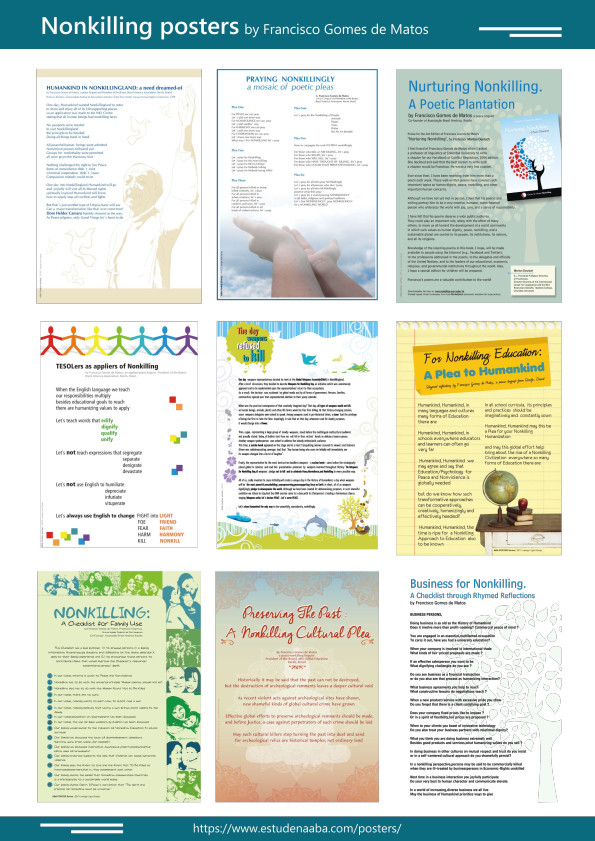
|
Prof. Gomes de Matos is one of the 30 nominees this year for 2021 Pax Christi USA Teacher of Peace Award. According to the Award description, “Each year, Pax Christi USA honors an outstanding peacemaker in the tradition of Sr. Thea Bowman, Dan Berrigan, César Chávez, Dianna Ortiz, Dorothy Day, Ray East, Bishop Thomas Gumbleton, and Pope Paul VI. This award recognizes women and men whose lives and work exemplify the theme of Pope Paul VI’s World Day of Peace message, ‘To reach peace, teach peace.’ ”
|
|
The project by Prof. Francisco Gomes de Matos, Founder CGNK Brazil is a collaboration with Ane Cleide Silva, Coordenação Design Center, ABA Global Education, Recife, Brazil. For additional information: Francisco Cardoso Gomes de Matos fcardosogomesdematos@gmail.com
|
|
|
|
4. Nonkilling Video Short
|
Fabricant de futur arts video: No Apartheid - a plea for refugee children.
|
This 8 min. arts video reminds us of the situation in Afghanistan and elsewhere. It has many collaborative elements - art from children living in Afghanistan, and also refugee children in Indonesia, photos from Kabul, and Fdf art work with the Kites of Peace project and photos from European artists. The music composed by Albert Gormezano is performed by Pep Serdà. The text in English, Dari and Pushto is from Samiullah Bakht.
|
|
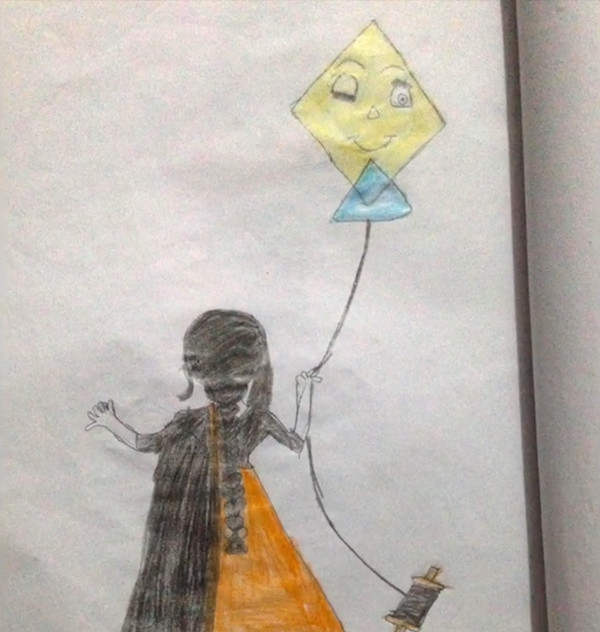
|
|
|
5. Nonkilling Reflections
(i) When genocide hits home: My hometown was an integral part of Canada’s attempt at cultural erasure by Terence McNamee
South Africa based Canadian expat author Terry McNamee reflects upon the discovery of the remains of 215 indigenous children last month at a Christian residential school site in Kamloops, British Columbia. (Number of such graves has risen to 700 with new findings in Saskatchewan province). This thoughtful piece points to complicity between state and religion in the racist colonial societies of the times and new atttempts at Truth and Reconciliation. McNamee writes:
|
“Guilt, responsibility and atonement sit less well in other countries. The United States and Britain, fortified by myths of a “shining city on a hill” and a “new Jerusalem”, still fall well short of Germany’s accounting and memorialisation. But the legacies of slavery and empire are being pushed to the fore by younger Americans and Britons. Australia has apologised for its Stolen Generations — the thousands of Aborigines forcibly taken from their families under similar assimilation policies as Canada — but there is much unfinished business. As for Japan’s whitewashing of its imperial crimes, or Italy’s playful attitude towards its fascist past, no reckoning is in sight.
For the more than 40 countries that have held truth commissions since the end of the Cold War, results have been mixed. Some, like South Africa’s, have helped countries move forward despite their limitations; others have only pretended to address past injustices and abuses to legitimise a new political order...
...[In Canada] Outside the classroom, pathways to reconciliation are thornier. Few if any countries have been as earnest and assiduous as Canada in trying to show their best selves to the world. Most Canadians still bristle at the idea that words like “genocide” and “colonialism” might apply to their country. It will take decades for such language to rest unopposed within the nation’s identity. If it ever does.”
|
|
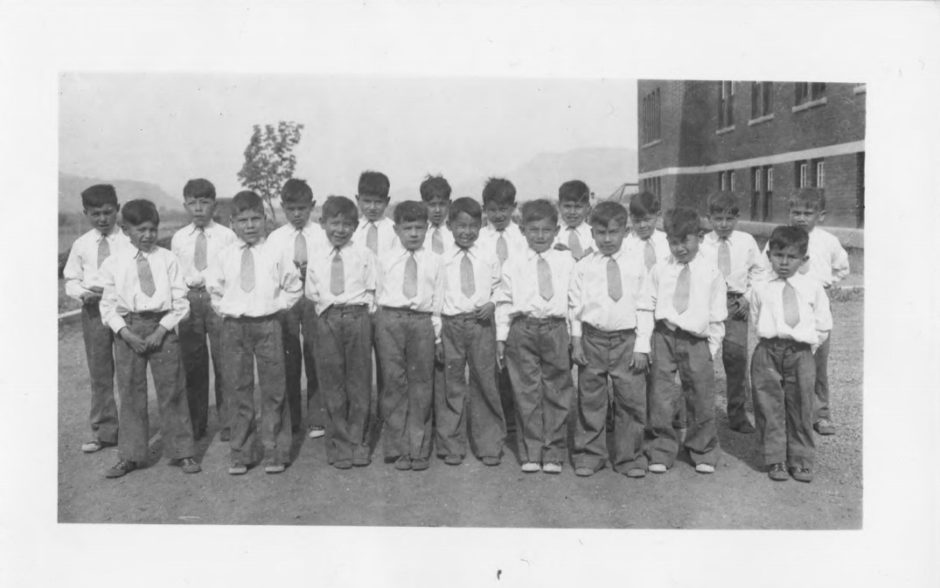
|
|
(ii) A Window into Peace Studies: Three Windows and Critical Peace/Nonviolence Research by Chaiwat Satha-Anand, Professor of Political Science, Thammasat University Director, Peace Information Center, Thammasat University, Thailand.
|
|
Satha-Anand writes: “Have you ever wondered what the word “window” means? When asked to write “A Window into Peace Studies” article for Hiroshima Peace Research Journal, the assignment led me to look up the etymological root, not of the word “peace” but “window,” a word seemingly common but does conceal something profound. Here is what I found: the word ‘windowʼ comes from an Old c.1200 Norse word “vindauga” which is a combination of “vindr” or ‘windʼ and “auga”: “eye”, or “to see.” Literally, it is “eye-hole” or “eye-door”. In Old Frisian ‘windowʼ literally means “breath-door.” Put another way, window allows us to breathe through and to see something outside our confinement and beyond. In my academic life as a peace/nonviolence researcher, I have been touched by extraordinary people whose teachings enable me to breathe and see the world in a particular way. They are my “windows into peace/nonviolence studies.” Through these windows, I have come to believe that peace studies without seriously taking account of nonviolence theory and practices leave much to be desired in a world presently consumed by deadly and destructive conflicts. What follows is a brief discussion of three “teachers” whose ideas constitute the three “windows” through which my understanding of peace/nonviolence has been formed.” The Windows help us to peer into three contemporary peace research pioneers: Glenn D. Paige (1929-2017), Gene Sharp ((1928-2018), and Johan Galtung (1930- ).
|
(iii) How Media Portrayals of Asians Fuel Anti-Asian Racism by Summer Mahmud and Rahul Varma.
|
The authors write: “Anti-Asian racism is embedded in U.S. foreign policy designed to terrorize and destabilize Southeast-Asian countries. Blaming China as a threat fuels nativist discrimination against Asians. The true history of Asian Americans is distorted by the media, absent in textbooks, and extravagantly tokenized in Hollywood war films and popular culture.”
|
(iv) Great Expectations! The Non-Proliferation Treaty and The Coming of The Messiah!
Viewpoint by Tariq Rauf from Vienna for IDN. See attachment:
|
|
(v) Architecture of a nonviolent city by Rivera Sun.
|
Rivera Sun writes: “Pace e Bene/Campaign Nonviolence defines violence as more than just physical. It can take the forms of cultural violence, systemic and structural violence, emotional and psychological violence, institutional violence and more. Knowing that they are all connected, a Nonviolent City endeavors to transform all the ways that harm is being caused. In the United States, the culture of violence is endemic — our “norm” is rooted in domination, exploitation and oppression. A Nonviolent City turns this paradigm upside down and implements effective alternatives to violence. The goal is not to simply end violence and return to an illusion of “neutral,” but rather to embed so many practices and approaches rooted in nonviolence that violence, itself, has a hard time taking place... It’s a tall order and a tough job, but it’s powerful, transformative work. Rather than trying to launch a thousand new initiatives, Nonviolent Cities teams can find ways to leverage their group in support of these efforts and campaigns.”
|
|
(vi) Politics of Protest: Anti-Narora Atomic Power Project campaign incident by Dhirendra Sharma (excerpted from "Uncharted Life's Journey: A Social Activist's Story" by Dr. Dhirendra Sharma, 2019).
|
|
Professor Sharma recalls: "India's Prime Minister Mrs. Indira Gandhi, in her election campaign in the 1970s had announced construction of a Nuclear Power plant at Narora located at Ganga( 65 miles from New Delhi). With some social activists and my Jawaharlal Nehru University (JNU) students, I decided to organize a protest march at the Narora Atomic Power Project site to halt its construction."
|
|
|
|
6. June 28: Global Nonkilling Day
(a) Global Colloquium on Creating a Nonkilling World. Gandhi Smriti and Darshan Samiti, Ministry of Culture, Government of India and the Centre for Global Nonkilling India hosted the Global Colloquium on “Creating an Affirmative Nonkilling World” on the 28th of June, to commemorate the birth anniversary of Late Professor Glenn D. Paige and to re-affirm the day as Global Nonkilling Day.
|
(b) Two creative videos sent for this special occasion from video artists of Fabricants de Futur: Marsha and Amelia Burke. The videos were made for Global Non Killing Day - 28th of June. As the video makers write: "One day killing will become unacceptable, just as other forms of violence have become unacceptable. No More Killing."
|
|
|
|
7. Nonkilling Song
Singer, songwriter and civil rights activist Eunice Kathleen Waymon (February 21, 1933 – April 21, 2003), was known professionally as Nina Simone. Her classic hit 'Feeling Good' with verse “And Freedom is mine, I know how good I feel” was performed by singer John Legend at the U.S. Inauguration Day concert on January 20th. To mark the anti-slavery day proclamation in USA, the Junateeth Day, here’s the original Simone song with lyrics.
|
|
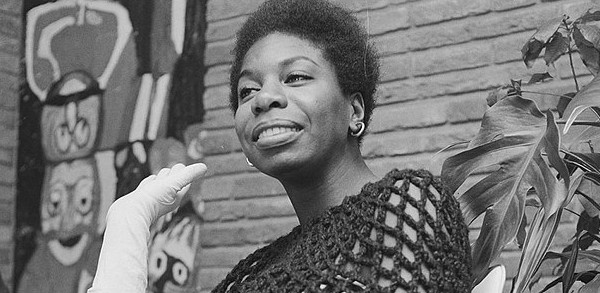
|
|
|
8. Nonkilling Doc Film
|
The International Chernobyl Project (1991) – Chernobyl: a look back in time
|
To mark the occasion of 35 years since the accident at the Chernobyl nuclear power plant, the International Atomic Energy Agency (IAEA) recently published a documentary that was made by the Agency thirty years ago - The International Chernobyl Project (1991). The film may look dated but it tells an important story – of international collaboration and support following the accident. The film covers a project launched in 1990 at the request of the Government of the USSR to assess the environmental and health situation in the areas of the Soviet Union contaminated by the Chernobyl nuclear accident, and to evaluate the measures taken by the authorities to safeguard the health of the population still living there. Some 200 scientists from 25 countries and seven international and regional organizations participated in the International Chernobyl Project. Almost 50 missions to the USSR were carried out in order to obtain the best available information and to make an independent assessment of the situation. The IAEA continues to provide key support and coordination to the decommissioning effort in Chernobyl (now called Chornobyl) as well as ongoing remediation work across the region.
|
|
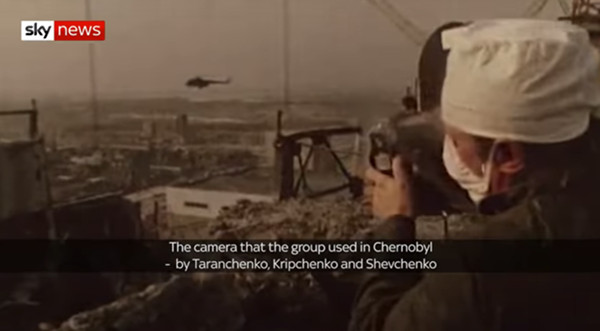
|
|
|
9. Nonkilling Journalism
|
|
|
Last Word
We will conspire to keep this blue dot floating and alive,
to keep the soldiers from gunning down the children.
|
to make the water clean and clear and plentiful,
to put food on everybody's table and hope in their hearts.
|
We will conspire to find new ways to say 'people' matter.
This conspiracy will be bold.
|
Everyone will dance, at wholly inappropriate times.
They will burst out singing non-patriotic songs.
And the not-so- secret password will be 'Peace'.
|
— David Krieger, Santa Barbara, Calif., USA
|
|
|
|
My deep gratitude to all who contributed and pointed to the material for the Letter.
I look forward as always to your inspirations, suggestions and comments.
|
|
"Nonkilling Culture crosses all the lines." —Glenn D. Paige
|
Nonkilling is THE measure of Human progress
|
[THIS IS AN INTERNAL NEWSLETTER OF THE NKARC. COPYRIGHT FOR ALL MATERIAL IN THE NEWSLETTER REMAINS PROPERTY OF THE SOURCES/WRITERS/ART CREATORS]
|
|
|
|
Stay in contact also on Social Networks
- Please feel free to contact NKARC Letter's coordinator at billbhaneja@nonkilling.org.
- You can also follow the Center for Global Nonkilling at these social networks:
|
 
|
|
|
|
|
|
|
|